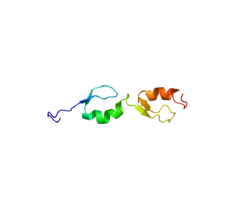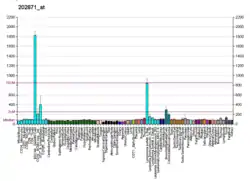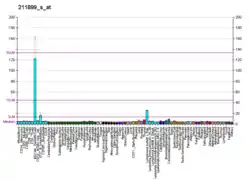TRAF4
TNF receptor-associated factor 4 (TRAF4) also known as RING finger protein 83 (RNF83) is a protein that in humans is encoded by the TRAF4 gene.[4][5][6]
TRAF4 is a member of the TNF receptor associated factor (TRAF) family, a family of scaffold proteins.[7] TRAF proteins connect IL-1R/Toll and TNF receptors with signaling factors that lead to the activation of NF-κB and mitogen-activated protein kinases. However, TRAF4 is not known to interact with TNF receptors and its cellular functions are not well understood.[8]
Protein interactions
TRAF4 has been shown to interact with neurotrophin receptor, p75 (NTR/NTSR1),[9][10] and negatively regulate NTR induced cell death and NF-kappa B activation. This protein has been found to bind to p47phox, a cytosolic regulatory factor included in a multi-protein complex known as NAD(P)H oxidase. This protein thus, is thought to be involved in the oxidative activation of MAPK8/JNK. Alternatively spliced transcript variants have been observed but the full-length nature of only one has been determined.[6]
A recent report indicates that TRAF4 binds to NOD-Like Receptors NOD1 and NOD2, and specifically inhibits activation of NF-κB by the activated NOD2-RIP2 complex [11] However, in malignant B cells TRAF4 can facilitate NFkB activation by the CD40 ligand provided by T cells, and in this context serves as an oncogene.[12] In this context TRAF4 levels are regulated by a MYC - miR-29 axis.
References
- GRCh38: Ensembl release 89: ENSG00000076604 - Ensembl, May 2017
- "Human PubMed Reference:". National Center for Biotechnology Information, U.S. National Library of Medicine.
- "Mouse PubMed Reference:". National Center for Biotechnology Information, U.S. National Library of Medicine.
- Regnier CH, Tomasetto C, Moog-Lutz C, Chenard MP, Wendling C, Basset P, Rio MC (Dec 1995). "Presence of a new conserved domain in CART1, a novel member of the tumor necrosis factor receptor-associated protein family, which is expressed in breast carcinoma". J Biol Chem. 270 (43): 25715–21. doi:10.1074/jbc.270.43.25715. PMID 7592751.
- Tomasetto C, Regnier C, Moog-Lutz C, Mattei MG, Chenard MP, Lidereau R, Basset P, Rio MC (Jan 1996). "Identification of four novel human genes amplified and overexpressed in breast carcinoma and localized to the q11-q21.3 region of chromosome 17". Genomics. 28 (3): 367–76. doi:10.1006/geno.1995.1163. PMID 7490069.
- "Entrez Gene: TRAF4 TNF receptor-associated factor 4".
- Wajant H, Henkler F, Scheurich P (June 2001). "The TNF-receptor-associated factor family: scaffold molecules for cytokine receptors, kinases and their regulators". Cell. Signal. 13 (6): 389–400. doi:10.1016/S0898-6568(01)00160-7. PMID 11384837.
- Kedinger V, Rio MC (2007). "TRAF4, the unique family member". Adv. Exp. Med. Biol. Advances in Experimental Medicine and Biology. 597: 60–71. doi:10.1007/978-0-387-70630-6_5. ISBN 978-0-387-70629-0. PMID 17633017.
- Ye X, Mehlen P, Rabizadeh S, VanArsdale T, Zhang H, Shin H, Wang JJ, Leo E, Zapata J, Hauser CA, Reed JC, Bredesen DE (October 1999). "TRAF family proteins interact with the common neurotrophin receptor and modulate apoptosis induction". J. Biol. Chem. 274 (42): 30202–8. doi:10.1074/jbc.274.42.30202. PMID 10514511.
- Krajewska M, Krajewski S, Zapata JM, Van Arsdale T, Gascoyne RD, Berern K, McFadden D, Shabaik A, Hugh J, Reynolds A, Clevenger CV, Reed JC (June 1998). "TRAF-4 expression in epithelial progenitor cells. Analysis in normal adult, fetal, and tumor tissues". Am. J. Pathol. 152 (6): 1549–61. PMC 1858434. PMID 9626059.
- Marinis JM, Homer CR, McDonald C, Abbott DW (2011). "A Novel Motif in the Crohn's Disease Susceptibility Protein, NOD2, Allows TRAF4 to Down-regulate Innate Immune Responses". J. Biol. Chem. 286 (3): 1938–1950. doi:10.1074/jbc.M110.189308. PMC 3023490. PMID 21097508.
- Sharma S, Pavlasova GM, Seda V, Cerna KA, Vojackova E, Filip D, Ondrisova L, Sandova V, Kostalova L, Zeni PF, Borsky M, Oppelt J, Liskova K, Kren L, Janikova A, Pospisilova S, Fernandes SM, Shehata M, Rassenti LZ, Jaeger U, Doubek M, Davids MS, Brown JR, Mayer J, Kipps TJ, Mraz M (December 2020). "miR-29 Modulates CD40 Signaling in Chronic Lymphocytic Leukemia by Targeting TRAF4: an Axis Affected by BCR inhibitors". Blood. doi:10.1182/blood.2020005627 (inactive 2021-01-20). PMID 33171493.CS1 maint: DOI inactive as of January 2021 (link)
Further reading
- Bradley JR, Pober JS (2001). "Tumor necrosis factor receptor-associated factors (TRAFs)". Oncogene. 20 (44): 6482–91. doi:10.1038/sj.onc.1204788. PMID 11607847.
- Masson R, Régnier CH, Chenard MP, et al. (1998). "Tumor necrosis factor receptor associated factor 4 (TRAF4) expression pattern during mouse development". Mech. Dev. 71 (1–2): 187–91. doi:10.1016/S0925-4773(97)00192-5. PMID 9507120. S2CID 13877166.
- Zapata JM, Pawlowski K, Haas E, et al. (2001). "A diverse family of proteins containing tumor necrosis factor receptor-associated factor domains". J. Biol. Chem. 276 (26): 24242–52. doi:10.1074/jbc.M100354200. PMID 11279055.
- Régnier CH, Masson R, Kedinger V, et al. (2002). "Impaired neural tube closure, axial skeleton malformations, and tracheal ring disruption in TRAF4-deficient mice". Proc. Natl. Acad. Sci. U.S.A. 99 (8): 5585–90. doi:10.1073/pnas.052124799. PMC 122813. PMID 11943846.
- Xu YC, Wu RF, Gu Y, et al. (2002). "Involvement of TRAF4 in oxidative activation of c-Jun N-terminal kinase". J. Biol. Chem. 277 (31): 28051–7. doi:10.1074/jbc.M202665200. PMID 12023963.
- Glauner H, Siegmund D, Motejadded H, et al. (2002). "Intracellular localization and transcriptional regulation of tumor necrosis factor (TNF) receptor-associated factor 4 (TRAF4)". Eur. J. Biochem. 269 (19): 4819–29. doi:10.1046/j.1432-1033.2002.03180.x. PMID 12354113.
- Strausberg RL, Feingold EA, Grouse LH, et al. (2003). "Generation and initial analysis of more than 15,000 full-length human and mouse cDNA sequences". Proc. Natl. Acad. Sci. U.S.A. 99 (26): 16899–903. doi:10.1073/pnas.242603899. PMC 139241. PMID 12477932.
- Sax JK, El-Deiry WS (2003). "Identification and characterization of the cytoplasmic protein TRAF4 as a p53-regulated proapoptotic gene". J. Biol. Chem. 278 (38): 36435–44. doi:10.1074/jbc.M303191200. PMID 12788948.
- Fleckenstein DS, Dirks WG, Drexler HG, Quentmeier H (2003). "Tumor necrosis factor receptor-associated factor (TRAF) 4 is a new binding partner for the p70S6 serine/threonine kinase". Leuk. Res. 27 (8): 687–94. doi:10.1016/S0145-2126(02)00325-9. PMID 12801526.
- Gerhard DS, Wagner L, Feingold EA, et al. (2004). "The Status, Quality, and Expansion of the NIH Full-Length cDNA Project: The Mammalian Gene Collection (MGC)". Genome Res. 14 (10B): 2121–7. doi:10.1101/gr.2596504. PMC 528928. PMID 15489334.
- Ma BY, Mikolajczak SA, Danesh A, et al. (2005). "The expression and the regulatory role of OX40 and 4-1BB heterodimer in activated human T cells". Blood. 106 (6): 2002–10. doi:10.1182/blood-2004-04-1622. PMID 15941918.
- Takeshita F, Ishii KJ, Kobiyama K, et al. (2005). "TRAF4 acts as a silencer in TLR-mediated signaling through the association with TRAF6 and TRIF". Eur. J. Immunol. 35 (8): 2477–85. doi:10.1002/eji.200526151. PMID 16052631. S2CID 560536.
- Abell AN, Johnson GL (2006). "MEKK4 is an effector of the embryonic TRAF4 for JNK activation". J. Biol. Chem. 280 (43): 35793–6. doi:10.1074/jbc.C500260200. PMID 16157600.





